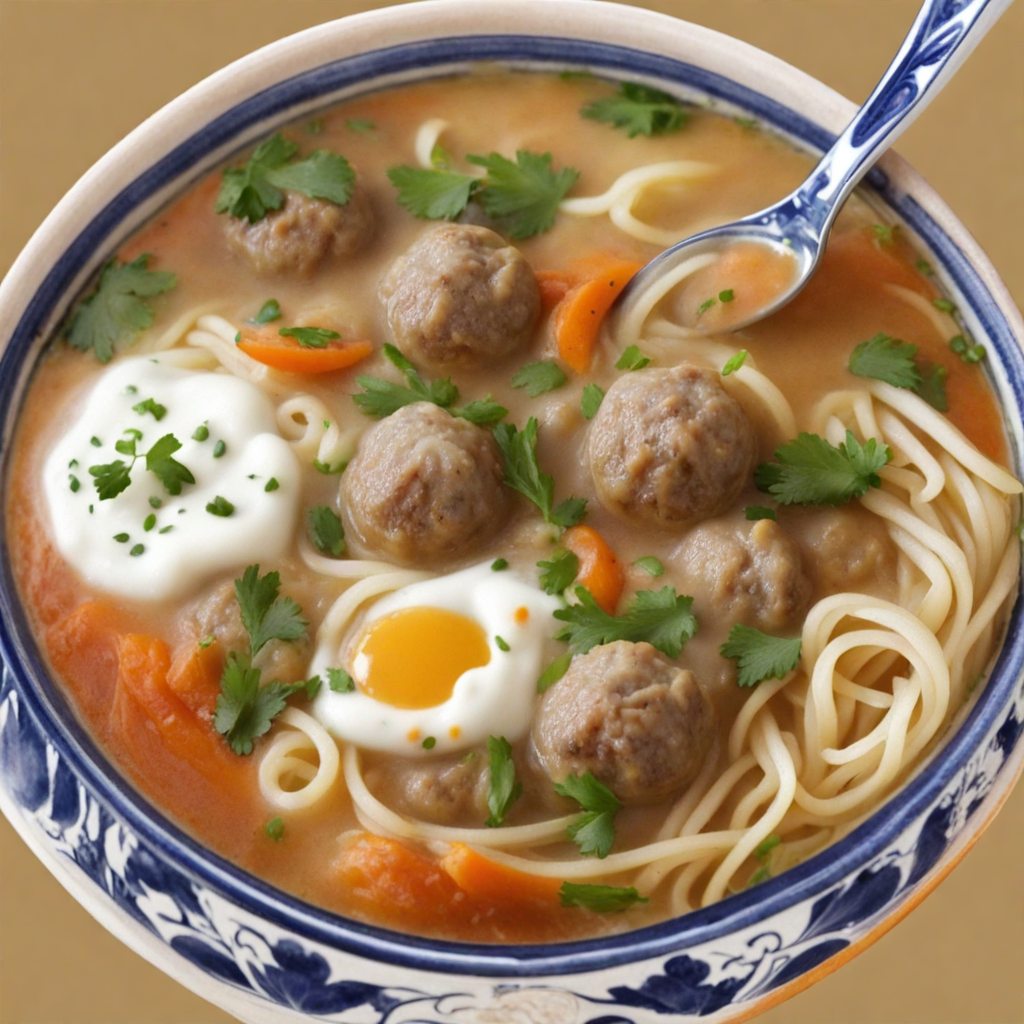Ashak
Ashak is a traditional Afghan dish that beautifully combines delicate flavors and textures, showcasing the rich culinary heritage of Afghanistan. At its core, Ashak consists of dumplings made from a soft, thin dough, which is filled with a mixture of finely chopped leeks and herbs. These dumplings are expertly crafted, often resembling large ravioli, and their tender exterior provides a perfect contrast to the flavorful filling inside. The leeks impart a mild, sweet onion flavor, which is enhanced by the addition of fresh herbs, creating a delightful and aromatic experience with each bite. Once the dumplings are prepared, they are boiled until just tender and then served with a luscious tomato sauce that adds a tangy richness to the dish. The sauce often includes garlic and ground meat, giving it a hearty depth. A drizzle of yogurt on top adds a creamy, cooling element, balancing the flavors beautifully while enriching the overall dish. The combination of the warm dumplings, the savory sauce, and the cool yogurt creates a symphony of taste and texture, making Ashak a truly comforting meal. In addition to its delicious taste, Ashak is often garnished with a sprinkle of dried mint or crushed red pepper, which elevates the dish even further. Each bite offers a unique burst of flavor, where the sweetness of the leeks harmonizes with the tangy sauce and the creamy yogurt. Whether enjoyed as a main course or as part of a larger spread, Ashak invites you to explore the vibrant culinary traditions of Afghanistan, making it an unforgettable addition to any food lover's repertoire.
How It Became This Dish
Origins of Ashak Ashak, a beloved traditional dish from Afghanistan, traces its origins back to the Pashtun regions and is believed to have been introduced by the Afghan Hazara community. The dish consists of dumplings filled with leeks and spices, served with a rich tomato sauce and often topped with yogurt and ground meat. The name "Ashak" comes from the Persian word "aash," which means soup, reflecting the dish's early association with comforting, hearty meals. The Hazara people, known for their culinary skills, particularly popularized Ashak, especially during the 19th century when trade routes connected various ethnic groups across Afghanistan. The tradition of making Ashak is deeply rooted in Afghan culture, where it is often reserved for special occasions and gatherings. Families take pride in preparing the dish, with recipes passed down through generations. Ashak has grown to become a symbol of hospitality in Afghan culture, often served to guests as a gesture of warmth and kindness. In this context, the dish transcends mere sustenance, embodying the values of community and togetherness that are central to Afghan society. \n\n Ingredients and Preparation The preparation of Ashak is an art form in itself, reflecting the rich agricultural landscape of Afghanistan. The primary ingredient is the dough, made from flour and water, which serves as the outer layer of the dumpling. The filling typically consists of finely chopped leeks, which are seasoned with spices such as salt, pepper, and sometimes turmeric for added flavor. The choice of spices can vary by family and region, showcasing the diversity of Afghan cuisine. The process of making Ashak is labor-intensive and requires skill. The dough is rolled out into thin circles, then filled with the leek mixture, folded, and sealed to create dumplings. Once assembled, the dumplings are boiled until tender and served with a sauce made from tomatoes, garlic, and other spices, often garnished with a dollop of yogurt and ground meat. The combination of flavors and textures creates a dish that is both satisfying and nourishing, highlighting the resources available to Afghan cooks. \n\n Cultural Significance Ashak holds a special place in the hearts and homes of many Afghans. It is often prepared during Ramadan as a celebratory dish to break the fast, showcasing its role in religious and cultural celebrations. The act of making Ashak can also foster familial bonds, as family members often gather to prepare the dish together, sharing stories and laughter in the process. This communal aspect of cooking reflects the Afghan emphasis on family and community, reinforcing the dish's significance beyond just a meal. Moreover, Ashak is often featured in festive occasions, such as weddings and holidays, where it serves as a centerpiece dish that brings people together. The vibrant colors of the sauce, the freshness of the leeks, and the rich yogurt combine to create a visually appealing dish that symbolizes abundance and generosity. In this sense, Ashak is more than just food; it represents the spirit of hospitality and celebration that characterizes Afghan culture. \n\n Regional Variations As Ashak has spread across Afghanistan and into neighboring regions, it has seen various adaptations that reflect local tastes and ingredients. In Kabul, where the dish is particularly popular, you might find Ashak served with a spicy meat sauce, while in the northern provinces, the filling might include a mix of other vegetables or herbs. This adaptability has allowed Ashak to evolve while retaining its core essence, making it a versatile dish that can be enjoyed in many forms. In recent years, Ashak has gained international recognition, making its way into Afghan restaurants and food festivals around the world. Chefs often experiment with the traditional recipe, incorporating modern culinary techniques or fusion elements that appeal to diverse palates. This evolution demonstrates how traditional dishes can adapt to contemporary tastes while still honoring their heritage. \n\n Modern-Day Relevance In the present day, Ashak is not only a dish steeped in tradition but also a symbol of resilience for the Afghan people, especially in the face of ongoing challenges. As Afghanistan continues to navigate its complex sociopolitical landscape, culinary traditions like Ashak serve as a reminder of the country's rich cultural heritage and the enduring spirit of its people. Afghan diaspora communities around the world have embraced Ashak as a way to connect with their roots, sharing the flavors of their homeland with future generations. Moreover, the global interest in Afghan cuisine has sparked a renewed appreciation for dishes like Ashak, leading to a broader understanding of Afghanistan's diverse culinary landscape. Through food, people can explore the history, culture, and identity of Afghanistan, fostering a sense of connection and empathy in an increasingly interconnected world. \n\n Conclusion: The Legacy of Ashak As Ashak continues to be prepared and enjoyed across Afghanistan and beyond, it remains a powerful symbol of cultural identity and community. Its rich flavors and intricate preparation are a testament to the skill and creativity of Afghan cooks who have preserved this culinary tradition throughout the years. In a world where food can serve as a bridge between cultures, Ashak stands out as a delicious reminder of the shared human experience, fostering connection and understanding among people from different backgrounds. In summary, Ashak is more than just a dish; it is a representation of Afghan history and resilience, a celebration of cultural heritage, and a means of connecting generations. Whether enjoyed at a family gathering or in a restaurant far from Afghanistan, Ashak embodies the warmth and hospitality that defines Afghan culture, ensuring that this cherished dish will continue to be savored for years to come.
You may like
Discover local flavors from Afghanistan







